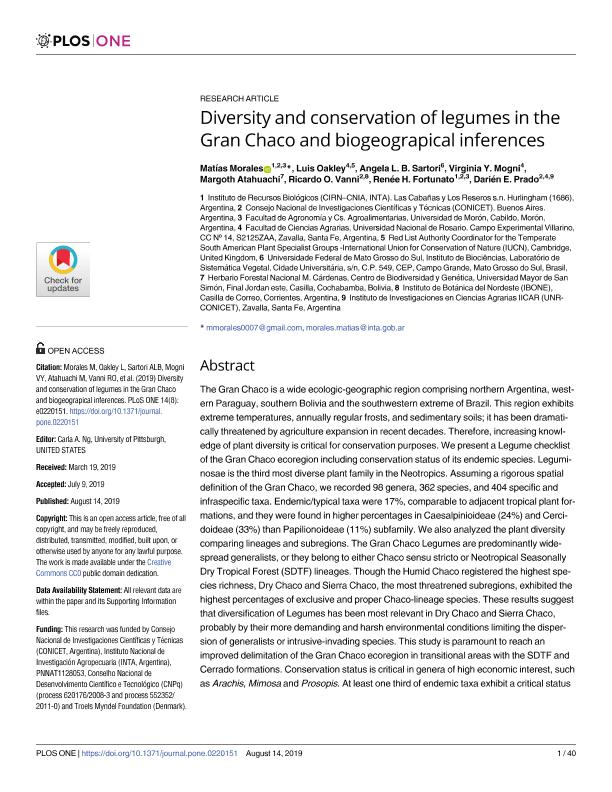Mostrar el registro sencillo del ítem
dc.contributor.author
Morales, Matias

dc.contributor.author
Oakley, Luis Jorge

dc.contributor.author
Sartori, Ángela L. B.
dc.contributor.author
Mogni, Virginia Yanina

dc.contributor.author
Atahuachi, Margoth
dc.contributor.author
Vanni, Ricardo Oscar

dc.contributor.author
Fortunato, Renée Hersilia

dc.contributor.author
Prado, Darien Eros

dc.date.available
2022-02-18T14:21:19Z
dc.date.issued
2019-08
dc.identifier.citation
Morales, Matias; Oakley, Luis Jorge; Sartori, Ángela L. B.; Mogni, Virginia Yanina; Atahuachi, Margoth; et al.; Diversity and conservation of legumes in the Gran Chaco and biogeograpical inferences; Public Library of Science; Plos One; 14; 8; 8-2019; 1-40
dc.identifier.issn
1932-6203
dc.identifier.uri
http://hdl.handle.net/11336/152298
dc.description.abstract
The Gran Chaco is a wide ecologic-geographic region comprising northern Argentina, western Paraguay, southern Bolivia and the southwestern extreme of Brazil. This region exhibits extreme temperatures, annually regular frosts, and sedimentary soils; it has been dramatically threatened by agriculture expansion in recent decades. Therefore, increasing knowledge of plant diversity is critical for conservation purposes. We present a Legume checklist of the Gran Chaco ecoregion including conservation status of its endemic species. Leguminosae is the third most diverse plant family in the Neotropics. Assuming a rigorous spatial definition of the Gran Chaco, we recorded 98 genera, 362 species, and 404 specific and infraspecific taxa. Endemic/typical taxa were 17%, comparable to adjacent tropical plant formations, and they were found in higher percentages in Caesalpinioideae (24%) and Cercidoideae (33%) than Papilionoideae (11%) subfamily. We also analyzed the plant diversity comparing lineages and subregions. The Gran Chaco Legumes are predominantly widespread generalists, or they belong to either Chaco sensu stricto or Neotropical Seasonally Dry Tropical Forest (SDTF) lineages. Though the Humid Chaco registered the highest species richness, Dry Chaco and Sierra Chaco, the most threatrened subregions, exhibited the highest percentages of exclusive and proper Chaco-lineage species. These results suggest that diversification of Legumes has been most relevant in Dry Chaco and Sierra Chaco, probably by their more demanding and harsh environmental conditions limiting the dispersion of generalists or intrusive-invading species. This study is paramount to reach an improved delimitation of the Gran Chaco ecoregion in transitional areas with the SDTF and Cerrado formations. Conservation status is critical in genera of high economic interest, such as Arachis, Mimosa and Prosopis. At least one third of endemic taxa exhibit a critical status of conservation or are endangered, many of them being relevant to inbreeding program or exhibiting multiple economic uses.
dc.format
application/pdf
dc.language.iso
eng
dc.publisher
Public Library of Science

dc.rights
info:eu-repo/semantics/openAccess
dc.rights.uri
https://creativecommons.org/licenses/by/2.5/ar/
dc.subject
ARGENTINA
dc.subject
BOLIVIA
dc.subject
BRASIL
dc.subject
CHACO
dc.subject
PARAGUAY
dc.subject
SEASONALLY DRY TROPICAL FORESTS
dc.subject.classification
Ciencias de las Plantas, Botánica

dc.subject.classification
Ciencias Biológicas

dc.subject.classification
CIENCIAS NATURALES Y EXACTAS

dc.title
Diversity and conservation of legumes in the Gran Chaco and biogeograpical inferences
dc.type
info:eu-repo/semantics/article
dc.type
info:ar-repo/semantics/artículo
dc.type
info:eu-repo/semantics/publishedVersion
dc.date.updated
2020-12-16T16:10:04Z
dc.journal.volume
14
dc.journal.number
8
dc.journal.pagination
1-40
dc.journal.pais
Estados Unidos

dc.journal.ciudad
San Francisco
dc.description.fil
Fil: Morales, Matias. Consejo Nacional de Investigaciones Científicas y Técnicas; Argentina. Universidad de Morón. Facultad de Agronomía y Ciencias Agroalimentarias; Argentina. Instituto Nacional de Tecnología Agropecuaria. Centro de Investigación de Recursos Naturales. Instituto de Recursos Biológicos; Argentina
dc.description.fil
Fil: Oakley, Luis Jorge. Consejo Nacional de Investigaciones Científicas y Técnicas; Argentina. Universidad Nacional de Rosario. Facultad de Ciencias Agrarias; Argentina. International Union for Conservation of Nature; Reino Unido
dc.description.fil
Fil: Sartori, Ángela L. B.. Instituto Nacional de Tecnología Agropecuaria. Centro de Investigación de Recursos Naturales. Instituto de Recursos Biológicos; Argentina. Universidade Federal do Mato Grosso do Sul; Brasil
dc.description.fil
Fil: Mogni, Virginia Yanina. Consejo Nacional de Investigaciones Científicas y Técnicas; Argentina. Universidad Nacional de Rosario. Facultad de Ciencias Agrarias; Argentina
dc.description.fil
Fil: Atahuachi, Margoth. Universidad Mayor de San Simón; Bolivia
dc.description.fil
Fil: Vanni, Ricardo Oscar. Consejo Nacional de Investigaciones Científicas y Técnicas. Centro Científico Tecnológico Conicet - Nordeste. Instituto de Botánica del Nordeste. Universidad Nacional del Nordeste. Facultad de Ciencias Agrarias. Instituto de Botánica del Nordeste; Argentina
dc.description.fil
Fil: Fortunato, Renée Hersilia. Consejo Nacional de Investigaciones Científicas y Técnicas; Argentina. Universidad Nacional de Rosario. Facultad de Ciencias Agrarias; Argentina. Instituto Nacional de Tecnología Agropecuaria. Centro de Investigación de Recursos Naturales. Instituto de Recursos Biológicos; Argentina
dc.description.fil
Fil: Prado, Darien Eros. Consejo Nacional de Investigaciones Científicas y Técnicas. Centro Científico Tecnológico Conicet - Rosario. Instituto de Investigaciones en Ciencias Agrarias de Rosario. Universidad Nacional de Rosario. Facultad de Ciencias Agrarias. Instituto de Investigaciones en Ciencias Agrarias de Rosario; Argentina
dc.journal.title
Plos One

dc.relation.alternativeid
info:eu-repo/semantics/altIdentifier/url/http://dx.plos.org/10.1371/journal.pone.0220151
dc.relation.alternativeid
info:eu-repo/semantics/altIdentifier/doi/https://doi.org/10.1371/journal.pone.0220151
Archivos asociados
